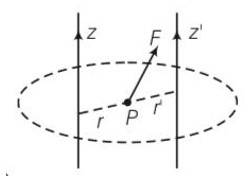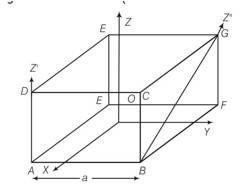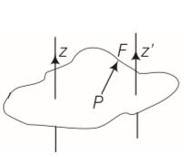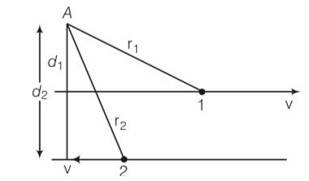(n-1) equal point masses each of mass m are placed at the vertices of a regular n-polygon. The vacant vertex has a position vector a with respect to the centre of the polygon. Find the position vector of centre of mass.
(n-1) equal point masses each of mass m are placed at the vertices of a regular n-polygon. The vacant vertex has a position vector a with respect to the centre of the polygon. Find the position vector of centre of mass.
-
1 Answer
-
This is a short answer type question as classified in NCERT Exemplar
Let b be the position vector of the centre of mass of a regular n-polygon.
(n-1) equal point masses are placed at (n-1) vertices of the regular n polygon, therefore for its centre of mass
rCM=
(n-1)mb+ma=0
B=-
Similar Questions for you
Case – I : When disk slides down
Case – II : When disk rolls down
This is a multiple choice type question as classified in NCERT Exemplar
a, b, d
a) according to the perpendicular axes theorem statement 1 is wrong
b) As z’|z so distance between them = a
So according to parallel axes theorem Iz’=Iz+m (a/ )2= Iz+ma2/2
Hence b is true
c) z’ is not parallel to z hence Parallel axes does not applied so statement is false
d) as x and y axes are symmetrical . hence Ix=Iy so d is true
d) as x and y axes are symmetrical . hence Ix=Iy so d is true
This is a multiple choice type question as classified in NCERT Exemplar
b, c
a) When r>r’

Torque about z-axis t=r F
b) t’=r’ which is along negative z axis
c) tz=Fr = magnitude of torque about z axis where r is perpendicular between F and z axis so torque along positive z axis is greater than negative z axis.
d) We are always calculating resultant torque about common axis. Hence total torque not equal to combination of torque along both axis of z, because they are not on common axis.
This is a multiple choice type question as classified in NCERT Exemplar
a, b, c, d
As we know torque = r F = rFsin
a) when forces act radially angle =0 hence torque =0
b) when forces are acting on the axis of rotation r=0 torque=0
c) when forces acting parallel to the axis of rotation angle =0 so torque =0
d) when torque by forces are equal and opposite torque net = t1-t2=0
This is a multiple choice type question as classified in NCERT Exemplar
(a), (b)As we know L= r p where r is position vector and p is the linear momentum . the direction of L is perpendicular to both r and p by right hand rule.
For particle 1
I1=r1 mv is out of the plane of the paper and perpendicular to r1 and p . similarly I2=r2 m (-v) is into the plane of the paper and perpendicular to r2 and -p.
Hence total angular momentum
L= L1+L2= I1=r1 mv+ (r2 m (-v)
L= mvd1-mvd2 as d2>d1
So total angular momentum will be inwards so I = l = mv (d2-d1)⊗
L= mvd1-mvd2 as d2>d1
So total angular momentum will be inwards so I = l = mv (d2-
Taking an Exam? Selecting a College?
Get authentic answers from experts, students and alumni that you won't find anywhere else
Sign Up on ShikshaOn Shiksha, get access to
- 65k Colleges
- 1.2k Exams
- 679k Reviews
- 1800k Answers



